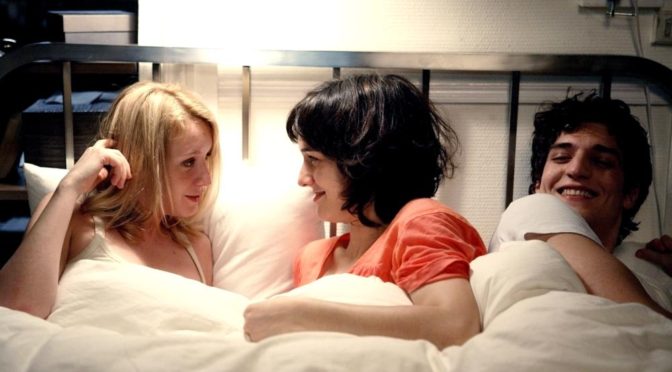Von Hannah Congdon
The last decade, and in particular the last few years, have witnessed the unprecedented breakout of queer films into the commercial mainstream. The likes of Brokeback Mountain, Blue is the Warmest Colour, Moonlight and Carol are now household names. And it has become almost a given that several TEDDY AWARD contenders each year will be picked up by major film distributors, as evidenced by the success of Call Me By Your Name, God’s Own Country and A Fantastic Woman. Whatever you might think of the respective merits and failings of those films, the growing appetite for LGBTQ+ film among distributors and audiences is undeniably a step in the right direction.
But there is a further pattern emerging that constrains the potential of these box-office hits (aside from the majority of those films containing white-only casts, and the poor representation of trans people – topics requiring their own discussions): the commercial template for a number of the films is to market them as monosexual, homosexual love stories. As a result, there is a seeming invisibility of bi-, pan- and poly-sexual love stories which disrupt the straight/gay binary. Where the New Queer Cinema of the ‘90s used queering techniques and narratives that exploded notions of gender and sexual classification, exploring the identities of LGBT as well as the spaces between those letters, the current trend seems to be to read queer romance narratives as monosexual love stories. In some instances, that reading is fair, but in many cases it over-simplifies the spectrum of the romances and sexualities depicted. If queer film is now making it to the mainstream, it’s about time critics and audiences alike learn to remove their monocles, and start viewing these films with the plurality from which they’re made.
Film critics play a crucial role in shaping popular conceptions and readings of publicly available films. Whilst labelling has a crucial and empowering role within the LGBTQ+ movement, it’s frustrating that so many critics stubbornly insist on branding films only ‘gay’ and ‘lesbian’, with little examination of the rest of the spectrum in queer narratives. Sticking, for now, with our big-hitting examples above: in Brokeback Mountain, Blue is the Warmest Colour, Carol and Call Me By Your Name, the central characters have not only same-sex romantic and sexual relationships, but also heterosexual relationships. In each case the heterosexual relationships have, for various reasons, become unsatisfying, paling into insignificance when compared with their newfound love interests. Nonetheless, these relationships are often depicted as real, loving and sexual, are pivotal aspects of the characters’ emotional development, and it is rarely made clear that they broke down simply because the character’s previous partner was of the “wrong” gender identity. Critics and audiences alike often fail to recognise the possibility that individuals can be attracted to people rather than genders, and in a number of reviews for these films the heterosexual relationships aren’t so much as mentioned.
Call Me By Your Name is perhaps the best example of this. Hailed as a ‘gorgeous gay love story’, the film and its source material reveal a far more complex story of sexual awakening than is typically addressed. The differing relationships Elio has with Marzia and Oliver arguably has more to do with the fact that the latter is far more mature than the first, than it has to do with their genders. The original text is more explicit still about Elio’s sexual fluidity:
“How strange, I thought, how each shadowed and screened the other, without precluding the other. Barely half an hour ago I was asking Oliver to fuck me and now here I was about to make love to Marzia, and yet neither had anything to do with the other except through Elio, who happened to be one and the same person.”

That so few commentators have pointed to the significance of Elio’s multiple sexual relations is a wearisome reminder of the continuing elision of bi- and pan- sexuality within film criticism, and indeed in society. It should be unnecessary in the current context of sexual politics to focus so heavily on categories and labels of sexuality, but the fact that openly bisexual director Desiree Arkhavan (The Miseducation of Cameron Post) chose the somewhat ‘in-your-face’ title of The Bisexual for her recent Channel 4 series is telling of how often the liminal space between gay and straight is overlooked, as well as the on-going reticence in screen industries and elsewhere to use the terms bi- and pan-sexual.
It’s interesting, too, that the criticism levelled at more obviously bisexual films and series is that they lack clean structure. The Bisexual was smeared as ‘inconsistent’, while Arkhavan’s 2015 film Appropriate Behaviour, about an American-Iranian bisexual woman going through a break-up, was called ‘temporally disoriented’ and full of ‘clutter’. Israeli-born director Tom Shkolnik’s ‘The Comedian’ used radically long cuts of improv to tell the story of a stand-up comedian torn between a romantic but largely asexual relationship with his female flatmate and his affair with an openly gay painter. Though receiving increasingly more positive receptions since its release in 2012, the film’s early critics said it lacked ‘shaping’ and ‘form’, describing it as ‘non-committal’. Christophe Honore’s French-language musical ‘Les Chansons D’Amour’, used song to narrate the four-way love affairs between its sexually fluid central characters, but was shunned for its ‘randomness’ and lack of ‘coherence’. What critics seem to miss is that all three filmmakers use narrative techniques that resist the standard structure typically used for monosexual romance films precisely because that structural messiness is far better suited to capturing the non-linearity of polysexual relationships. Maria Pramaggiore summarises this phenomenon succinctly in her essay ‘Representing Bisexualities’. She refers to the ‘compulsory monosexuality’ of many Hollywood films, arguing that “conventional coupled romance narratives, whether concerned with gay, lesbian or heterosexual scenarios, make it difficult to recognise or to imagine bisexuality other than as a developmental stage prior to “mature” monogamous monosexuality”. She goes on to point out that:
“chronological narrative structures that assign more weight and import to the conclusion…may be less compatible with bisexual reading strategies, which focus on the episodic quality of a nonteleological temporal continuum across which a number of sexual acts, desire and identities might be expressed”.
Rather than criticising the tangled story-telling of the afore-mentioned films, then, we might praise the filmmakers for finding fitting methods of conveying what are inherently tangled narratives.
It’s in keeping with the topic of non-linearity that I’d like to finish by turning back to what is rapidly being recognised as a classic of the New Queer Wave at the end of the 20th century. In Todd Haynes’ 1998 glam-rock musical drama Velvet Goldmine, the film’s hallucinatory structure is as sprawling and fluid as its characters’ sexualities. Despite being a bit of a flop on its release, it’s been undergoing a critical renaissance over the past few years. I recently came across a review of the film that provides a rare and refreshing example of a critic engaging with the binary-breaking methodologies of the film, and of queer film theory itself:
“Velvet Goldmine is often called a gay film, but that obscures the universal resonance of its queer coming-of-age narrative. Better to think of it as a bisexual film that uses non-binary sexuality as a metaphor for the boundless possibilities of youth”.
Judy Berman’s assessment captures the whirling complexity of the film’s transgressive narrative and techniques, and is an exemplary contrast with the determinedly monosexual readings of more contemporary queer films. Many of the films listed in this article do, indeed, contain lesbian and gay relationships, and it’s important to use those terms to denote them. But, as film theorist Maria San Filippo astutely puts it, “human sexuality and desire are irreducible to and always already in excess of binary ways of thinking”. These films are lesbian, gay, and more. To collapse them into easily marketable boxes of sexuality is to diminish the work that they do in exploring liminal spaces between binaries. And as long as we continue to be mired by an attitude that someone is either ‘this’ or ‘that’, there’s little hope for greater progress in the representation of trans and non-binary people, too. No doubt the TEDDY Films of this year will continue to dismantle such barriers, as well as tackling the need for diversity and intersectionality within queer film. As an audience, let’s do credit to the complexity of their stories by bearing in mind Haynes’ cheeky intertitle in Velvet Goldmine:
“Meaning is not in things but in between them.”
― Norman O. Brown
